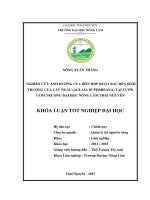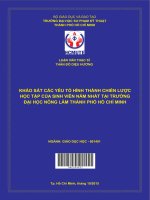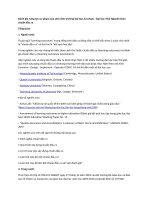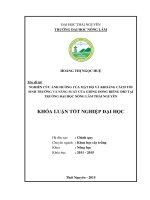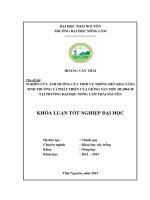Đánh giá năng lực tự chủ của sinh viên chương trình tiên tiến đại học nông lâm thái nguyên thông qua mô hình câu lạc bộ tiếng anh
Bạn đang xem bản rút gọn của tài liệu. Xem và tải ngay bản đầy đủ của tài liệu tại đây (611.52 KB, 71 trang )
THAI NGUYEN UNIVERSITY
SCHOOL OF FOREIGN LANGUAGES
-------------------------
TRAN THI NAM PHUONG
AN EVALUATION OF STUDENTS’ AUTONOMY IN THE
ADVANCED EDUCATION PROGRAM - THAI NGUYEN
UNIVERSITY OF AGRICULTURE AND FORESTRY THROUGH
THE MODEL OF ENGLISH CLUB
(Đánh giá năng lực tự chủ của sinh viên chương trình tiên tiến Đại
học Nông Lâm Thái nguyên thông qua mô hình câu lạc bộ tiếng
Anh)
M.A THESIS
Field: English Linguistics
Code: 8220201
THAI NGUYEN - 2019
THAI NGUYEN UNIVERSITY
SCHOOL OF FOREIGN LANGUAGES
------------------------
TRAN THI NAM PHUONG
AN EVALUATION OF STUDENTS’ AUTONOMY IN THE
ADVANCED EDUCATION PROGRAM - THAI NGUYEN
UNIVERSITY OF AGRICULTURE AND FORESTRY THROUGH
THE MODEL OF ENGLISH CLUB
(Đánh giá năng lực tự chủ của sinh viên chương trình tiên tiến
Đại học Nông Lâm Thái nguyên thông qua mô hình câu lạc bộ tiếng Anh)
M.A THESIS
(APPLICATION ORIENTATION)
Field: English Linguistics
Code: 8220201
Supervisor: Nguyen Thi Hong Minh Ph.D.
THAI NGUYEN - 2019
DECLARATION
I hereby certify that the thesis entitled “An evaluation of Students’
Autonomy in the Advanced Education Program - Thai Nguyen University of
Agriculture and Forestry through the Model of English club” is the result of my
own research for the Degree of Master at the Faculty of Foreign Languages, Thai
Nguyen University, and this thesis has not been submitted for any other degrees.
Thai Nguyen, September 2019
Supervisor
Nguyen Thi Hong Minh
Student
Tran Thi Nam Phuong
Số hóa bởi Trung tâm Học liệu và Công nghệ thông tin – ĐHTN
ACKNOWLEDGEMENTS
I would like to express my gratitude to Nguyen Thi Hong Minh. PhD for
assisting me in the process of implementing this study. This paper would not have
been completed without her constant support and encouragement. Her patience and
helpful criticism helped me confidently express my ideas into this paper. I regard
myself extremely fortunate in having her as my dissertation supervisor.
I would also like to express my sincere thanks to all my lecturers at the
Faculty of Foreign Languages, Thai Nguyen University for their valuable lectures
which have helped to enrich my theorical knowledge as well as my practical skills.
Finally, I would also like to express my deep gratitude and love to my
devoted parents and sisters who gave me time and encouraged me to complete
this study.
Số hóa bởi Trung tâm Học liệu và Công nghệ thông tin – ĐHTN
TABLE OF CONTENTS
DECLARATION ........................................................................................................ i
ACKNOWLEDGEMENTS ....................................................................................... ii
LIST OF ABBRIVIATIONS ......................................................................................v
LISTS OF FIGURES AND TABLES ...................................................................... vi
ABSTRACT ............................................................................................................. vii
Chapter 1: INTRODUCTION .................................................................................1
1.1. Rationale .......................................................................................................1
1.2. Aim of the study............................................................................................3
1.3. Scope of the study .........................................................................................3
1.4. Significance of the study...............................................................................4
1.5. Structure of the study ....................................................................................4
Chapter 2: LITERATURE REVIEW .....................................................................5
2.1. Autonomy......................................................................................................5
2.1.1. Definition ...................................................................................................5
2.1.2. Dynamic model of Autonomy....................................................................5
2.1.3. Autonomy degrees .....................................................................................7
2.2. Language learning environment....................................................................8
2.2.1. Definitions..................................................................................................8
2.2.2. Types of learning environment ..................................................................9
2.3. Extracurricular activities .............................................................................11
2.3.1. Definitions................................................................................................11
2.3.2. Benefits of extracurricular activities ........................................................11
2.3.3. Relationship between autonomy and extracurricular activities ...............12
2.4. Community-based English club ..................................................................13
2.4.1. Definition .................................................................................................13
2.4.2. Activities in community-based English club ...........................................13
2.5. Previous studies...........................................................................................14
Chapter 3: METHODOLOGY ..............................................................................17
3.1. Participants of the study ..............................................................................17
Số hóa bởi Trung tâm Học liệu và Công nghệ thông tin – ĐHTN
3.1.1. Respondents of the questionnaires ...........................................................18
3.2. Research method .........................................................................................18
3.2.1. Action research.........................................................................................18
3.2.2. Mixed method ..........................................................................................20
3.3. Data collection instruments.........................................................................20
3.3.1. Questionnaire ...........................................................................................20
3.3.2. Observation ..............................................................................................21
3.4. Procedures of data collection ......................................................................22
3.5. Procedures of data analysis .........................................................................22
Chapter 4: FINDINGS AND DISCUSSIONS ......................................................23
4.1. Results of the pre-survey questionnaire about autonomy ...........................23
4.2. Results of the post-survey questionnaire about autonomy .........................28
4.3. Results of the questionnaire about the implement of the English club.......34
4.3.1. Frequency of participation .......................................................................34
4.3.2. Levels of usefulness and interest of activities employed in the English club .35
4.3.3. Challenges confronted by students when participating in the English
club 37
4.3.4. Expectations of students for future implement of the English club.........38
4.4. Findings from observation ..........................................................................38
4.5. Discussion of all findings............................................................................39
Chapter 5: CONCLUSION AND RECOMMENDATIONS ..............................40
5.1. Conclusion...................................................................................................40
5.2. Recommendations .......................................................................................41
5.3. Implications.................................................................................................43
5.4. Limitations ..................................................................................................44
5.5. Suggestions for futher studies ....................................................................44
REFERENCES ........................................................................................................45
APPENDIX A ..........................................................................................................49
APPENDIX B ..........................................................................................................51
APPENDIX C ..........................................................................................................52
Số hóa bởi Trung tâm Học liệu và Công nghệ thông tin – ĐHTN
LIST OF ABBRIVIATIONS
AEP
: Advanced Education Program
EFL
: English as a Foreign Language
ELT
: English Language Teaching
IELTS
: The International English Language Testing System
TUAF
: Thai Nguyen University of Agriculture and Forestry
Số hóa bởi Trung tâm Học liệu và Công nghệ thông tin – ĐHTN
LISTS OF FIGURES AND TABLES
Figure 2.1: Dynamic of learner Autonomy (Tassinari, Maria Giovanna (2010)).......6
Figure 3.1: Action research cycle..............................................................................19
Table 4.1: results of the pre-survey questionnaire ....................................................23
Table 4.2: Statistics of the result of the pre-survey questionnaire ............................26
Table 4.3: Results of the post-survey questionnaire .................................................28
Table 4.4: statistics of the post-survey questionnaire result .....................................31
Table 4.5: Pair differences between pre-survey and post-survey .............................33
Table 4.6: Realibilty of the pre-survey and post-survey results ...............................34
Table 4.7: Frequency of participating in the English club ........................................34
Table 4.8: Results of the level of usefulness and interest survey .............................35
Table 4.9: Challenges confronted by students when participating in the English club
.... 37
Table 4.10: Expections of students for future implement of the club.......................38
Số hóa bởi Trung tâm Học liệu và Công nghệ thông tin – ĐHTN
ABSTRACT
The study intend to exame the autonomy among students in Advanced
Program - University of Agriculture - Thai Nguyen University. To the end, 30
students who are memberd of English club in this program were selected to
participate in the study. Initially, a survey was carried out to collect the data by
introducing a questionnaire and an observation, next students experience 10 week
participating in the English club with the activities were chosen by the leaders of the
club. After 10 weeks, the survey was conducted the second time, to collected the
data. The result of the two surveys were compared and analized, and the outcome of
this process was the result of the automomy of students before and after 10 weeks
of participation in the English club. The data showed the alteration in positive way
of autonnomy among students.
Số hóa bởi Trung tâm Học liệu và Công nghệ thông tin – ĐHTN
Chapter 1: INTRODUCTION
This chapter discusses the reasons for selecting this study, as well as the
scope and participants of the study. The structure of this study is also intoduced in
this chapter.
1.1. Rationale
Recently, learner-center teaching method has been introduced to many
schools in Viet Nam, this method is applied to be the placement for teacher-center
teaching method that was used for a long time before the revolution of education.
The application of a new teaching method revealed the importance of the education
that concentrates on the development of students rather than teachers’ performance.
In other words, the improvement of learners in various aspects should be paid
attention. Vietnam culture influenced considerably by the Confuciasm owing to the
invasion of China in the past, as a result, the ideology of people in Viet Nam partly
bears the characteristics of Confuciasm which curbed the freedom in classroom of
students as well as increased the dependence of students on teachers; that prevented
the development of learners’ autonomy in both classes and in daily life, while
autonomy is an indespensible part of each person’s characteristics to help them
have a more successful life. According to Benson (2003, p.290), reseachers content
that the most significant capabilities are those that provide learners with their
planning of learning actitivies, management their progress and evaluation their
results. It is noticeble that these abilities are hard to be found in a variety number of
students in Viet Nam due to the impact of culture and teaching methodology that
have been existing for a long time.
English clubs have gradually become common in Viet Nam, it appeared in
not only tertiary institutions but also in secondary and high schools where this kind
of learning has demonstrated the effectiveness in English level as well as life skills
of students. English clubs could be described as playgrounds where students
Số hóa bởi Trung tâm Học liệu và Công nghệ thông tin – ĐHTN
illustrate their personnalities, creativity and values that teachers can hardly
recognize in
Số hóa bởi Trung tâm Học liệu và Công nghệ thông tin – ĐHTN
classrooms. It is worthy noticing that tertiary education emphasises the development
of autonomy on students; therefore, there is little of teachers’ guidance in these
education instituitions which leads to the signifcance of English clubs where
students have opportunities to share their experience and help each other in different
fields of life.
Since its establishment, English club of Advanced Education Program(EAP)
in Thai Nguyen University of Agriculture and Forestry (TUAF) has been showing its
attraction to the students of the University due to the fact that the number of
members always maintains from 20 to 30 including both Viet Nam students and
foreign students. The meeting of the club are held twice a week with the control of a
managing board, the club members are involved in the variety of indoor and outdoor
activities which are designed creatively and logically, suitable with members’ level.
In addition, the club plays an pivotal role in the improvement of English speaking
skills of students which was proved through results in classes, some members got
5.0 to 5.5 in IELTS tests. The success of this club is undeniable which was
acknowledged by both teachers and students in the University, however, there are
also aspects changing after participating in activities of English club recieved no
comment from both members and teachers at University. One important aspect that
should be received greater attention is the improvement of autonomy has been
ignored for a long time despite the fact that the autonomy is a key factor
contributing to the well-rounded development of the students in their higher
education life.
This thesis was choosen because of the requirement to have an evaluation of
learners’ autonomy after a period taking part in English club, what are strong points
and weak points and what should be implemented to increase the development of
autonomy for members of club in particular and for students in general.
Số hóa bởi Trung tâm Học liệu và Công nghệ thông tin – ĐHTN
1.2. Aim of the study
The study focuses mainly on the investigation of alterations in the students’
autonomy after a period taking part in the English club organized by the Advanced Education Program - Thai Nguyen University of Agriculture and Forestry. Firstly,
the study concentrates essentially on the assessment of autonomy among students in
Advanced - Education Program. Secondly, the study explores the changes in terms
of autonomy of English club participants. Thirdly, the study investigates
possibilities and provides recommendations to improve the implementation of the
English club for the development of learners’ autonomy.
Particularly, it seeks to anwer the following questions:
1. How are students in Advanced - Education Program assessed in terms of
autonomy through the model of English club?
2. To what extent does the participation in the English club improve learners’
autonomy?
3. What could be done to better enhance the implementation of English club
in Advanced - Education Program for the improvement of students’ autonomy?
1.3. Scope of the study
The study was conducted among students in the Advanced Education
Program at Thai Nguyen University of Agriculture and Forestry. The Advanced
Education Program trains two majors manely Food Technology and Environment
Management which provides students with one year learning English and 3 years
studying major subjects that are taught in English. The participants of the study,
mainly the first and second year students with the shortage of English skills, are
members of an English club founded 2 years ago with the support in terms of
financial and academic aspect by the director of the Program. The operating rule of
this club is all members have to join activities using English and there is no usage of
books. The meetings take place twice a week with the change of meeting locations
from meeting room of library to
Số hóa bởi Trung tâm Học liệu và Công nghệ thông tin – ĐHTN
coffee shops. The study examined the alterations in the autonomy of 30 students
who took part in activities of the English club.
1.4. Significance of the study
The study was conducted with the purpose of measuring the level of
autonomy among members of English club at Thai Nguyen University of
Agriculture and Forestry and the effects of participation in the English club
had made on the participants in order to propose some recommendations for the
improvement of the English club in terms of fostering English ability of students.
1.5. Structure of the study
Chapter 1: Introduction - provide an overview of the study
Chapter 2: Literature review - provide theory basement of learners’ autonomy and
findings of some previous studies to shed light on the significance of the study
Chapter 3: Methodology - an overview of the Dynamic Model which is applied in
the survey and research methods for this study.
Chapter 4: Findings and discussions
Chapter 5: Conclusion and recommendations
Số hóa bởi Trung tâm Học liệu và Công nghệ thông tin – ĐHTN
Chapter 2: LITERATURE REVIEW
This chapter presents the definition of the autonomy, Dynemic model of
autonomy, learning environment, extracurricular activities as well as communitybased English club.
2.1. Autonomy
2.1.1. Definition
Autonomy has been defined by different researchers throughtout the time.
Holec (1981, p.3) consider autonomy as “the ability to take charge of one’s own
learning”; according to Holec, this capacity is obtained rather than nature. Little
(1995, p.176) introduced autonomy “aims to equipe learners to play an active role
in participatory democracy”. The perspective of Little was supported by Benson
(2008, p.4) when he said “ because the concept of autonomy in learning draws its
meaning from the concept of personal autonomy, it is centrally concernded with the
kind of learning that best helps people to lead autonomous lives”. Autonomous life
can be interpreted as te individual freedom of choosing goals and relations an
important part of a person’s well-being according to Raz (1986, as cited in Benson
2008); in other words, autonomy is the individual freedom and people’s rights to
make different choices. Macaro (1997, p.168) presented two main ingredients for the
existant of autonomy “autonomy is an ability which is learnt through knowing how
to make decisions about the self as ell as being allowed to make those decisions”,
which means that to be autonomous is not adequate, the learners must be placed
under the condition to employ their autonomy.
2.1.2. Dynamic model of Autonomy
Dynamic model of learner autonomy was designed basing on a large number
of research with the investigation of perspectives and definitions of different writters
around the world. Learner autonomy is a complicated structure with “various
dimensions and components” namely a cognitive and metacognitive component, an
Số hóa bởi Trung tâm Học liệu và Công nghệ thông tin – ĐHTN
effective and a motivational component, an action-oriented component and a social
component. Basing on these crucial components, definitions and characteristics of
autonomy, a dynamic model of Autonomy and its descriptor which put all these
factors into relation was designed. As the explorative - interpretative research was
applied, the first versions of dynamic model was discussed workshops with the
contribution of experts and researchers, the first workshop was organized at the
Centre de Reserches et d’Applications Pédagogiques en Languages at the
l’Université de Lorraine. The first versions were introduced in German and French
and the translated into English.
The dynamic model of Autonomy was presented in a sphere shape and
“entails the dimensions previously identified as being characteristic of learner
Autonomy: an action - oriented dimension, a cognitive and metacognitive
dimension, an affective and motivational dimension.” Descriptor for each
component was introduced with concrete descriptions of “competencies, skills and
bevavior formulated as can-do statements”.
Figure 2.1: Dynamic of learner Autonomy (Tassinari, Maria Giovanna (2010))
Tassinari in 2010 states “this dynamic autonomy model consists of several
components. All the components are interconnected and are not organized
Số hóa bởi Trung tâm Học liệu và Công nghệ thông tin – ĐHTN
hierarchically. Only the category managing my own learning is super-ordinate. The
connections between the different components are represented by the arrows.”
There are various aspects of Autonomy which learners or teachers can choose
for self- assessment or student assessment with provided questionares and explicit
descriptor. However, within the limitation of this study, this paper will concentrate
mainly on one aspect that related to the activities and charecteristics of an English
club.
Choosing materials and methods is the skill of selecting a suitable book or
materials for learning process which need improving gradually. Completing tasks
is the component that requires the study place equipped adequatly with tools and
resources. Monitoring refers to the reflection on learning relating subjects from the
topic to the learning process which enables someone to relize thier own strong
points and weak points in learning process. Evaluating is the most significant part
of the autonomous learning process. “Evaluating one’s own progress and one’s own
language competencies is the hardest part of autonomous language learning. It
requires practice and normally exchange with other learners, native speakers,
learning advisors and
teachers.” Cooperating is
the
evaluation of
social
dimension and interactive dimension of learning language autonomously. The
ability to study things with others, to finish the tasks and exchange information with
parters as well as the capability of forming plan and reflecting on stages of learning
process of each person. Managing my own learning is “a superordinate area,
which connects all aspects of the learning process” and “summarizes important
steps and phases of autonomous learning from the other areas”. Structuring
knowledge is the common zone of every autonomous phrases and activity.
2.1.3. Autonomy degrees
In 1990s, there were writers who investigated Autonomy in terms of degree,
Nunan (1997, p.195) listed five levels of “learner action” which not only involved in
the sequence of activity progress in language textbooks but also related to “content”
Số hóa bởi Trung tâm Học liệu và Công nghệ thông tin – ĐHTN
and “process” including awareness, involvement, intervention, creation and
transendence.
In his paper (1997, p.81), Littlewood stated three-stage model dealing with
language aquisition, learning approach and personal development. In terms of
language acquisition, Autonomy was considered as the ability to “operate
independently with a language” and can use it to convey messages in any contexts Autonomy as a communicator. In classroom, Autonony could be defined as the
ability of learners to be responsible for their learning - Autonomy as a learner. In
larger situations, Autonomy involved in a higher-level which considered Autonomy
as a person.
In 1997, Macaro (pp. 170-172) put forward three-stage model relating to
“autonomy of language competence”, “autonomy of language learning competence”
and “autonomy of choice and action”.
Another point of view came from Scharle and Szabó (2000, p.1), their book
named three phase in the development of Autonomy including “raising awareness”,
“changing attitudes” and “transferring roles”.
2.2. Language learning environment
2.2.1. Definitions
Schmuck and Schmuck (1978) were the pioneers who introduced the
definition of learning environment as what occurs throughout the interation between
teacher-student and student-student and emphasis on components of learning
environment namely interpersonal relationships, emotional and structural style of
teaching, organization of classrooms, expectations and attitides of teachers towards
students, gender and age of students, level of controllation, problems of discipline.
In 1995 Entwistle and Tait defined learning environment as the entire
learning condition including lectures, assigments, assessments and the availability of
learning resources.
Số hóa bởi Trung tâm Học liệu và Công nghệ thông tin – ĐHTN
Byrne, Hattie and Fraserin 1986 considered ideal learning environment as the
place where maximum learning and achievement happen.
Zedan (2010, p.76) shared the similar point of view when describing the
desirable learning environment as being “supportivem egalitarian, democratic and
organized according to pre-determined rules and regulations”.
Miler, Ferguson and Byrne (2000) took the relation between behavior
construction and teaching environment into consideration when suggesting that the
classroom regime-be it strict or not-and fair actions of the teachers were significant
components of the learning environment which affects learning behavior.
2.2.2. Types of learning environment
Throughout the time, the employment of indoor and outdoor learning
activities have been improving to boost academic performance and skills among
students. According to Malone (2008) if students have the opportunities to
expose to both types of learning, their imagination and creativity are expanded.
Malone asserted the harmony between indoor and outdoor leaning environments
varifies the aptitude that learners can perform to exhibit authentic inquiry in
various subject areas.
Indoor learning and outdoor learning reveal numerous similarities and
differences. Greenaway (1999, as cited in Beard and Wilson, 2006) stated a variety
aspects of similarities between indoor and outdoor learning through his stance on
indoors and outdoors. First and foremost, students can explore the benefits and
drawbacks of both learing environments through powerful images and neutral
setting. Second, students have the oppportunities to manage their own learning
owning to the responsibilities they are in charge of when exposing to both
environment. Third, the dimention of knowledge that students acquire depending on
the investigation they make into both environments. Finally, the diversity of
learning and teaching approaches can be applied in both indoors and outdoors to
Số hóa bởi Trung tâm Học liệu và Công nghệ thông tin – ĐHTN
motivate the learning process of students. It is also agreed by many scholars
worldwide that learning
Số hóa bởi Trung tâm Học liệu và Công nghệ thông tin – ĐHTN
environments are ajusted to be suitable with the aim of imparting knowledge,
undestanding, skills and attitudes effectively.
Spodek and Saracho (2006) believed that indoors and outdoors are two
separate worlds; one of the differences between two environments is outdoors
motivate more type of activities than indorrs; the open space allows more movemets
for students while the indoors is limited by the size of classrom. According to Bruce
in 2010 sensory learning experiences are available in the outdoors; students can
experience the plants in the nature, feel its textures, colors and shapes, hear the
sound of feet stepping on dry leaves.
There is a large amount of research on the influence of indoor learning on
enhancing the performance of students in science understanding. Wardle in 2004
claimed that immerse indoor environments and positive influence on the quality of
learning process; if indoor classrooms are designed in harmony with some factors of
outdoors, students’ interests and needs can be improved. The indoors can be
associated with a wide range of resources and materials to supply the learning of
science in the majority of room setting unlike the outdoors, according to Bruce
(2010). On the other hand, Jackman in 2011, indoor learning limits the motivation
and interest of students for many reasons. He insisted that the noise effect can curb
the concentration of students; therefore, calm but active classroom is necessary
to enhance the effectiveness of learning process.
According to Jeffery (2006), outdoor learning enhances students’ enjoyment
and willingness to take part in the outdoors rather than indoors. Fox and Avramidis
(2003, as cited in Rickinson, 2004) supported that the outdoors “learning objectives
are achieved alongside enjoyable and challenging activities which cannot be
performed in conventional settings”. Broda (2007, as cited in Hayden, 2012) said
that “outdoor education motivates the reluctant learner, adds variety to teaching and
learning; helps increase student achievement…and is compatible with many current
practices in education”. The outdoor environment offers the space for operating
different teaching and learning activities, hence students’ academic performance has
Số hóa bởi Trung tâm Học liệu và Công nghệ thông tin – ĐHTN
the possibility to be improved. Nevertheless, in 2011, White present certain negative
impacts of outdoor learning that hinder the development of learning process among
students owing to the time wasting activities and physical condition of students.
2.3. Extracurricular activities
2.3.1. Definitions
Extracurricular activities are all activities that take place out of the regular
school curriculum. According to Holloway (1999, p.87) stated that “the activities are
coluntary, and students do not recieve grades for academic credit for them”. These
activities are organized outside of the school curriculum, but within the setting of
the school. These activities are defined as something done for pleasure and purpose
that related a group (Merriam-Webster, 2016). Cadwallader (2002) defined
extracurricular activities as the activities that students take part in after the regular
school day finished.
2.3.2. Benefits of extracurricular activities
In 2001, Beson defined the definition of “out-of-class-learning” as “any kind
of learning that takes place outside the classroom and involves self-instruction,
naturalistic learning or self-directed naturalistic learning”. When investigating the
variety of activties students can select, it is significant to take benefits of these
activities into consideration; Eccles (2003) stated that when taking part in voluntary,
school-organized or
extracurricular activies, participants will gain school
participation and achievement due to the fact that interpersonal skills, positive social
norms, membership and stronger connection among people are improved. Daley &
Leahy, 2003, emphasised the importance of participating in extracurricular physical
activities that affected the mental well-being of young participants by releaving
stress, keeping fit and having the feeling of confidence of appearances.
Extracurricular activities help to improve students’ life and they provide students
with addtional skills that will be usefull for their future life (Reynolds, 1996). Klesse
in 1994 recognized
Số hóa bởi Trung tâm Học liệu và Công nghệ thông tin – ĐHTN
the positice relationship between involvement in extracurricular activities and
success in many aspects of life.
2.3.3. Relationship between autonomy and extracurricular activities
Language learning environment allows students to practise more that involves
students in learning and become successfull learners. Learners are successful when
they possess the capability of applying different metacognitive learning strategies
basing on different and effective learning conditions. According to Wenden (1998),
effective metacognitive strategies include planning personnal aims and criteria for
evaluating learning performance. Continuously assessing learning process provides
learners with the opportunities to work out the reasons for their successes and
failures, as well as learn from their own and others mistakes (Rodriguez
Manzanaresis & Murply, 2010). When learners obtain these matacognitive
strategies and have the ability of managing their learning , they can see themseves
as monitor of thier own learning (Victori and Lockhart, 1995, p.224). As a result,
when students start to be responsible for their autonomous learning and obtain
success, they will realize their own success depdending on them.
According to Balçikanli (2010), autonomy in out of class language learning
activities allow students to be confident and encourage them to make thier own
dicisions. Furthermore, if learners are approaching out of class language activities
autonomously, they will possess more positive points of view about English
learning, according to Wu (2012). Therefore, when the positive attitude towards
language learning is formed, students are tend to maintain their autonomous learning
(Cotterall,
1999).
“Interdependence” is necessary component of learner autonomy, autonomy
out of the class can be organized in communities where relationships and
experiences of learners must be taken into account (Borrero &Yeh, 2010); according
to them, this consideration will develop students’ English speaking ability, their
feelings about sucess as well as steady interdependence relationship. Therefore, Gao
Số hóa bởi Trung tâm Học liệu và Công nghệ thông tin – ĐHTN
in 2009 stated that the learners’ participation in the community enhance their
autonomous learning.
Số hóa bởi Trung tâm Học liệu và Công nghệ thông tin – ĐHTN
2.4. Community-based English club
2.4.1. Definition
The club is a worlwide phenomenon concept, community-based English
clubs are informal meetings of people who gather according to a schedule and often
voluntarily; members of clubs come from different parts of a community, town,
village or school for practicing English, they can be professionals or students at
different levels, they commit to speaking English during the meetings and they are
willing to participate in activities encouraging their English. The primary aim
motive of English club is to communicate and practise English in terms of reading,
writing, listening, speaking as well as critical thinking by discussing real-life
prolems and exposing themselves to real conversations. Many researchers support
the operation of English club, according to Au (1998), language acquisition is most
effective when people apply language for meaning targets and make connection
with experience, knowledge, culture through authentic language practice.
2.4.2. Activities in community-based English club
Debate is a discussion about a topic that different people have different views;
it enables speakers to express their points of view.
Presentation is a process of illustrating a topic to the audience. It is helpful for
practicing speaking and express stance towards a problem. The length of a
presentation depends on the speaker or speaking situation.
Poster making is a process of choosing a topic and designs a suitable picture
to demonstrate the designer’ idea to show on a large paper.
Scavenger hunt is a game that organizers prepare a list of requiring items
which the players have to seek and gather. It is usually played in teams.
Role-play is the shift of an individual’ behavior to assume a different role that
usually has no common with the actor’ real characteristics.
Số hóa bởi Trung tâm Học liệu và Công nghệ thông tin – ĐHTN




